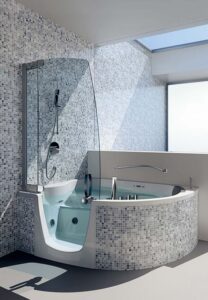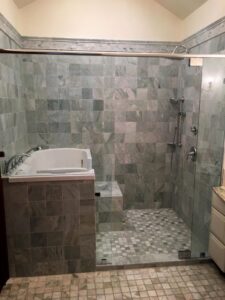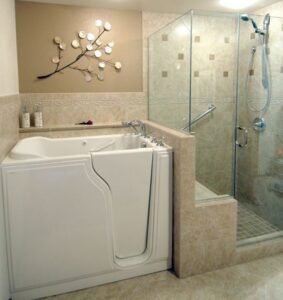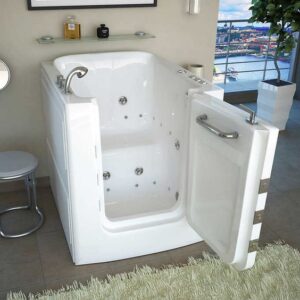Deciphering the Costs: How Much Are Walk-In Tubs Installed?

The increasing popularity of walk-in tubs highlights a growing trend towards bathroom safety and comfort, especially among those with mobility challenges or the elderly. These innovative fixtures provide a safe, accessible bathing option, merging luxury with functionality. As such, walk-in tubs have become a focal point for homeowners looking to enhance their bathroom’s accessibility and safety.
However, a common query arises: how much is the installation of walk-in tubs? This question underscores the need for clarity around the costs associated with purchasing and installing a walk-in tub. Our goal is to demystify these expenses, providing you with the knowledge needed to make an informed decision about integrating a walk-in tub into your home.
Walk-In Tub Installation Explained
The process of installing a walk-in tub is a detailed operation that goes beyond merely switching out an old tub. It requires a thorough examination of the current bathroom configuration to ascertain if the existing plumbing is adequate for a walk-in tub, along with adjustments to the area as needed. Familiarizing oneself with both the product costs, like the basic walk-in tub cost, and the service fees for installation is essential.
This understanding helps homeowners plan financially and prevent unforeseen charges, especially when considering models with features like quick drain technology, which may influence the overall expense.
Types of Walk-In Tubs and Their Impact on Cost
The selection of walk-in tubs available today includes a range of models, from basic walk-in tubs to advanced versions equipped with amenities such as quick drain technology and built-in seats, all of which play a significant role in determining their price.
The walk-in tub cost varies depending on its design, capabilities, and extra features, like the addition of a walk-in tub shower, with the inclusion of a built-in seat elevating both the user’s convenience and the tub’s cost.
Soaker Tubs: These are the most basic form of walk-in tubs, providing a safe, accessible bathing experience without additional therapeutic features. The cost of most walk-in soaker tubs starts at a lower price point, making them an affordable option for those on a tight budget.
Air Tubs: Air tubs are equipped with air jets that create a gentle massaging effect, offering therapeutic benefits to users. The walk-in tub cost for air tub models is generally higher due to the added technology and comfort features.
Bariatric Tubs: Designed to accommodate larger individuals, bariatric tubs are more spacious and have a higher weight capacity. The walk-in tub prices for bariatric models are typically higher, reflecting their specialized design and construction.
Walk-In Showers: For those who prefer showering, walk-in showers provide easy access and safety features similar to walk-in bathtubs. The installation and tub cost of walk-in showers can vary widely, depending on the size and features included.
Walk-In Bath and Shower Combo: Combining the functionality of a walk-in bath with the convenience of a shower, these combo units are ideal for those who want the best of both worlds. The cost of these models is on the higher end due to their dual functionality.
Each type of walk-in tub has its own set of benefits and considerations. When planning for a walk-in tub installation, it’s important to factor in the initial purchase price along with any potential modifications to your bathroom’s plumbing and layout to accommodate the new fixture.
The Installation Essentials
Achieving a flawless walk-in tub installation hinges on meticulous preparation, particularly in terms of plumbing requirements and spatial logistics. The selection of the walk-in tub, influenced by reputable walk-in tub brands and specific models such as acrylic tubs or wheelchair accessible tubs, must align with the existing bathroom’s dimensions, allowing for door operation and potential plumbing modifications. Familiarity with walk-in tub prices, including considerations for models designed to prevent walk-in tub falls, is vital for accurately anticipating the project’s financial and practical demands.
Cost Elements of Walk-In Tub Installation

Understanding the costs involved in installing a walk-in tub is essential for homeowners considering this significant bathroom upgrade. From the initial purchase of the tub to the final installation, various factors contribute to the overall expense. This section aims to provide a detailed analysis of these costs, ensuring that individuals are well-informed about what to expect financially when they decide to proceed with a walk-in tub installation.
Tub Purchase Price Range
Features such as built-in seats, air jets in hydrotherapy tubs, and safety features like grab bars widely influence the price range for new walk-in tubs. Basic models often start at a lower price point, while luxury versions, particularly hydrotherapy tubs, can significantly increase the investment due to their advanced features.
The material of the tub, whether it’s acrylic, fiberglass, or high-end ceramic or porcelain tile, also affects the tub’s cost. On average, homeowners might expect to spend anywhere from a few thousand dollars for a basic model to tens of thousands for a tub with all the bells and whistles.
Installation Costs Unveiled
The installation of a walk-in tub involves more than simply replacing an old tub or shower stall; it may require extensive bathroom remodeling, including adjustments to plumbing and possibly the addition or reinforcement of ceramic or porcelain tile. The typical range of installation fees can vary significantly based on the complexity of the job, with costs increasing if there’s a need to remove an old tub, reconfigure plumbing, or if the installation requires structural modifications to accommodate the new walk-in tub.
Additional features, such as the installation of grab bars or the inclusion of air jets and hydrotherapy features, can also influence the overall installation expenses. Homeowners should budget for not just the tub costs but also for labor and any necessary bathroom modifications, which can together total a few thousand dollars on top of the purchase price of the tub.
The Value of Professional Installation
When it comes to integrating a walk-in bathtub into your home, the importance of professional installation cannot be overstated. Ensuring the safety and long-term usability of this durable medical equipment involves a level of complexity that goes beyond the skill set of most DIY enthusiasts. This section highlights the critical reasons why hiring experienced professionals is essential for installing walk-in baths, focuses on the potential risks of DIY projects, and guides choosing the right installer.
Risks of DIY Installation
Improper Sealing and Leakage: Without professional expertise, there’s a high risk of incorrect sealing around the walk-in bathtub, leading to leaks that can cause water damage to floors and walls, potentially resulting in costly repairs.
Safety Hazards: DIY installations might overlook critical safety features such as proper grounding of electrical components or the secure installation of grab bars, increasing the risk of accidents and injuries during use.
Structural Issues: Installing a larger tub or a two-seater walk-in bathtub without professional guidance can lead to structural problems. These tubs are significantly heavier, especially when filled with water, and may require additional support that a non-professional might not adequately provide.
Voided Warranty: Many manufacturers require installation by certified professionals for the warranty to remain valid. DIY installation could void this warranty, leaving homeowners without protection if the tub malfunctions.
Choosing the Right Installer
Selecting a reliable and experienced installer for your walk-in bathtub installation is crucial to ensuring the safety and effectiveness of your investment. Here are key tips to help you choose the right professional for the job:
Experience with Walk-In Bathtubs: Choose an installer who has extensive experience with walk-in baths and whirlpool tubs. Their familiarity with different models, including two-seater tubs and those with advanced features like heated seats, ensures they can handle the unique challenges these installations present.
Licenses and Certifications: Verify that the installer has the necessary licenses and certifications to perform bathroom installations in your area. This ensures they adhere to local building codes and industry standards.
References and Reviews: Ask for references from previous clients, and check online reviews. This can give you insight into the installer’s reliability, quality of work, and customer service.
Detailed Quotes: A trustworthy installer will provide a detailed quote that breaks down the installation costs, including labor and any additional equipment needed. Transparency about costs helps avoid surprises and reflects the installer’s honesty.
Safety First: Ensure the installer emphasizes the importance of safety features and compliance with ADA guidelines if applicable. This focus on safety is essential for the usability and long-term enjoyment of your walk-in bathtub.
DIY vs. Professional Installation
When considering the installation of a walk-in bathtub, homeowners might weigh the options between DIY and professional installation. Each approach has its implications for installation cost, labor costs, and the overall success of the tub installation, especially when dealing with advanced features like whirlpool jets or ensuring the tub is wheelchair accessible.
DIY Installation
This option might seem appealing due to the potential for reduced labor costs. However, the complexity of installing a walk-in bathtub—from ensuring watertight seals to correctly installing whirlpool jets—requires a high level of expertise. Additionally, the physical demands of tub installation, including handling the heavy unit and making precise modifications to the plumbing, can be challenging. Homeowners considering this route must also consider the potential for increased installation costs in the long run if errors occur, leading to water damage or the need for professional correction.
Professional Installation
Opting for a professional installation ensures that the job is done correctly from the start, with experienced technicians who are familiar with the specific requirements of installing walk-in bathtubs, including those that are wheelchair accessible. While the upfront labor costs might be higher than a DIY attempt, professionals bring the necessary tools, skills, and knowledge to avoid common pitfalls. Moreover, a professional installation often comes with warranties on labor and installation, providing homeowners peace of mind that the installation cost includes not just the placement of the tub but also the assurance of safety and functionality.
While DIY installation might initially seem cost-effective, the technical challenges of correctly installing a walk-in bathtub—especially models with sophisticated features like whirlpool jets—and ensuring it is wheelchair accessible typically make professional installation the safer and more reliable choice.
Influential Factors on Installation Cost

When considering the installation of a walk-in tub, it’s important to understand that various factors can influence the overall cost. These factors range from the physical characteristics of the bathroom itself to the specific features and materials of the tub chosen. This section explores how elements such as bathroom size, tub features, and existing plumbing conditions can affect the installation cost, providing valuable insights for homeowners planning to make this beneficial upgrade.
Customization and Its Price Impacts
Custom features in a walk-in tub, such as hydrotherapy jets, significantly impact installation costs. These luxurious additions require more complex plumbing and electrical work, leading to higher labor costs. Additionally, tub material plays a crucial role; for instance, a standard tub made from high-grade materials with added features like hydrotherapy jets will cost more both in terms of the tub price and the installation process.
Homeowners need to consider how each customized feature will not only enhance their bathing experience but also affect the overall financial investment required.
Spatial and Plumbing Considerations
The layout of the bathroom and existing plumbing significantly influence the complexity and cost of walk-in tub installation. For bathrooms with less floor space or those that require floor reinforcement to accommodate the weight of a standard tub filled with water, installation costs can increase. Converting traditional tub or shower units to a walk-in model might necessitate the relocation of plumbing fixtures or the installation of a new floor pan, further adding to the expense.
Especially in homes designed for older adults, ensuring the new tub fits comfortably within the available space without extensive modifications is key to managing installation costs effectively.
Financing the Installation of Your Walk-In Tub
Navigating the financial aspects of installing a walk-in tub can be as complex as the installation process itself. With various options available, from savings to loans and grants, understanding how to manage the costs effectively is crucial. This section delves into the methods homeowners can use to finance their walk-in tub installation, ensuring the enhancement of their bathing experience without undue financial strain.
Budgeting for Your Project
Effective budgeting is key to smoothly financing the installation of a walk-in tub. Start by getting a detailed estimate of the tub’s cost, including any custom features like water jets, colored lights, or slip-resistant floors that can elevate the bathing experience but also affect the price.
Consider setting aside a portion of your savings over time to cover these costs, or explore setting up a dedicated savings account specifically for this project. Planning and saving diligently can mitigate the financial impact of your walk-in tub installation, allowing for a stress-free addition to your home.
Exploring Financing and Aid
For those who may not have the full amount saved, there are financing options available. Personal loans can offer the funds needed for the tub and its installation, often with manageable repayment terms. Additionally, seniors or individuals with disabilities might qualify for grants or aid designed to make homes more accessible, such as installing bariatric tubs or tubs with built-in seating for enhanced safety and comfort.
Investigating these options can provide financial relief, making the installation process more accessible to those who can benefit most from a walk-in tub’s features.
Navigating the Installation Process

Understanding the walk-in tub installation process is essential for homeowners considering this significant home improvement. The journey from the initial assessment to completion involves several key steps, each important to ensuring a smooth transition and a successful outcome. This guide aims to demystify the process, providing clear insights into what homeowners can expect during each phase of the installation.
Preparing for Installation Day
- Clear the Bathroom: Remove all personal items, rugs, and movable fixtures from the bathroom to create a clear workspace for the installers.
- Ensure Access: Make sure there is a clear path from the entrance of your home to the bathroom. This might involve moving furniture or securing pets in another room.
- Cover Surfaces: To protect your floors and any remaining fixtures, consider laying down protective coverings or asking the installers if they will do so.
- Discuss Details with Installers: Have a final discussion about the installation process and confirm any last-minute details, such as the location of handheld shower placements or any specific requests regarding porcelain tile or two-seater walk configurations.
The Day of Installation
On the day of installation, the installation team will begin by removing your existing tub or shower unit, which may involve some adjustments to the plumbing and the removal of porcelain tile if necessary. Installers will then position the new walk-in tub, ensuring it fits correctly and connects to existing plumbing. Features such as handheld shower attachments, gentle massage jets, and heated surfaces will be installed and tested. This phase is crucial, as it involves not just the physical installation of the tub but also ensuring that all features are operational and accessible, even in those hard-to-reach areas.
Post-Installation: Ensuring Everything Is Perfect
- Inspect the Installation: Check the walk-in tub thoroughly to ensure all features work correctly, from the door seal to the jets for a gentle massage and heated surfaces.
- Test the Features: Run water through the tub, test the handheld shower, and try any therapeutic features to ensure everything functions as expected.
- Understand Maintenance: Ask for maintenance tips specific to your model, including cleaning recommendations for hard-to-reach areas and advice on keeping the porcelain tile in good condition.
- Review Warranty and Support: Make sure you understand the warranty details, how to claim it if needed, and whom to contact for support or repairs.
Enhancing Your Walk-In Tub Experience
Installing a walk-in tub in your home is not just about safety; it’s also about creating a luxurious, spa-like experience that you can enjoy every day. With the right features and upgrades, your walk-in tub can provide not just easy access and safety but also unparalleled comfort.
Safety Features That Matter
Safety is paramount when it comes to walk-in tubs, especially for homes with older adults or individuals with mobility challenges. Essential safety features include non-slip floors to prevent falls, handrails for extra support, and low thresholds for easy access. These features are crucial in preventing accidents and ensuring that users can enjoy their bathing experience with peace of mind.
Comfort Upgrades Worth Considering
For those looking to elevate their bathing experience, consider adding extra features like hydrotherapy jets, which offer a gentle massage that can soothe sore muscles and improve circulation. Heated seats are another luxurious upgrade, ensuring warmth and comfort from the moment you sit down. These comfort upgrades, while requiring additional plumbing work, significantly enhance the overall experience and make your walk-in tub a haven of relaxation.
Maintenance and Care for Longevity

Proper maintenance and care are essential for keeping your walk-in tub in top condition, ensuring its longevity and optimal performance. Regular cleaning and attentive maintenance can prevent common issues and extend the life of your tub.
Regular Cleaning and Maintenance
Keeping your walk-in tub clean is crucial for both hygiene and functionality. Regular cleaning practices include rinsing the tub after each use to remove soap residue, cleaning with mild, non-abrasive cleaners to protect the surface, and drying with a soft cloth to prevent water spots. Additionally, it’s important to regularly check and clean the jets and filters in hydrotherapy and other extra features to prevent blockages.
Addressing Common Maintenance Issues
Common maintenance issues with walk-in tubs include slow drains, leaky seals, or malfunctioning features like outward opening doors. Most of these issues can be resolved with routine checks and minor adjustments. However, if you encounter persistent problems or complications with plumbing work, it’s wise to call a professional. This ensures that any issues are addressed promptly and correctly, maintaining the safety and functionality of your standard tubs and upgraded features alike.
In Summary
Understanding the full scope of costs and considerations involved in walk-in tub installation is crucial for anyone considering this valuable addition to their home. The journey from selecting the right walk-in tubs to the final walk-in tub installation encompasses not just the purchase price but also the nuanced details of each model, whether it’s a basic walk-in tub, a standard walk-in tub, or a more luxurious air tub. Walk-in tub costs can vary significantly, influenced by features such as walk-in tub shower options and tub shower combo designs, which cater to diverse needs and preferences.
It’s imperative to carefully select your installation service to ensure the best experience. A reputable installer can make a significant difference in the functionality and enjoyment of your walk-in shower or tub, ensuring that most walk-in tubs are installed with precision and care. By prioritizing professional installation, you can enhance the safety, comfort, and overall satisfaction of your walk-in tub, making it a worthwhile investment for years to come.
Take the next step towards enhancing your home’s safety and comfort by considering a walk-in tub. Don’t hesitate to reach out for professional advice on installation services, ensuring you make an informed decision that suits your needs and preferences. Transform your bathroom into a haven of accessibility and relaxation today.
